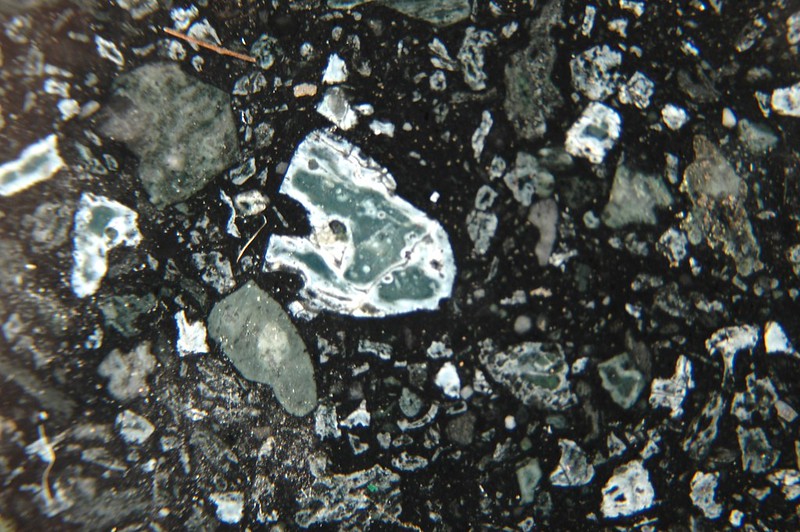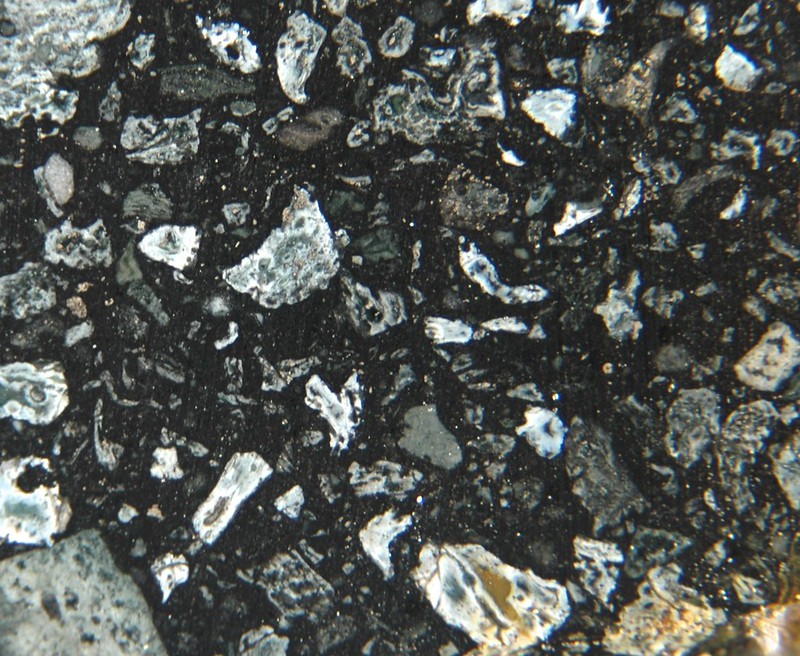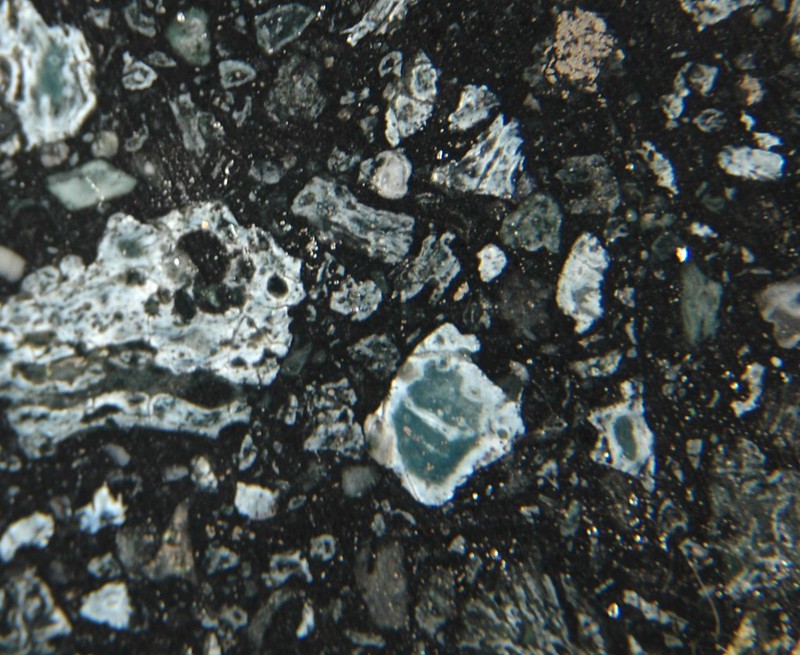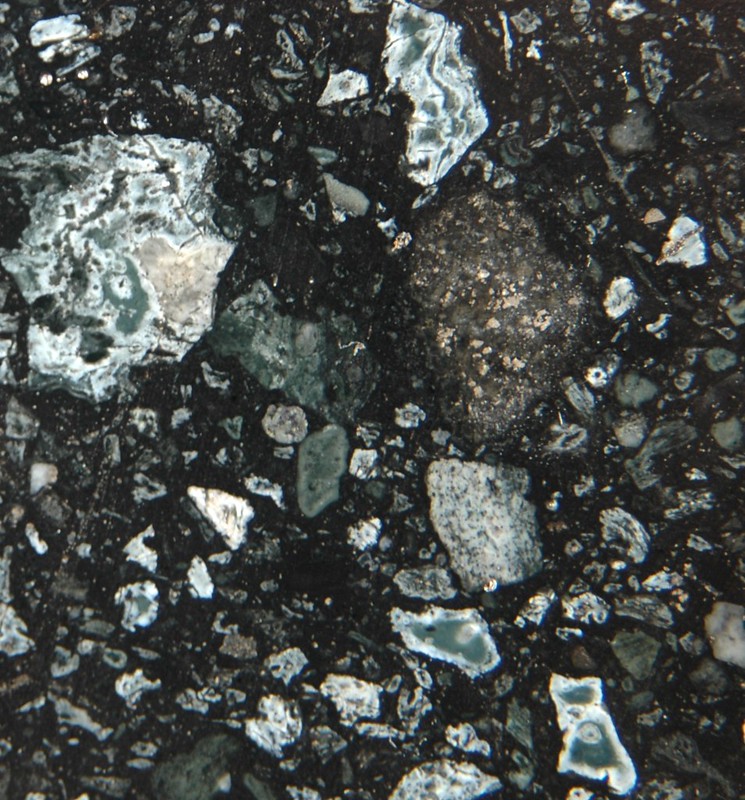jamesp
Cave Dweller 
Member since October 2012
Posts: 36,612
|
Post by jamesp on Jan 11, 2015 12:08:43 GMT -5
Buckyball Fullerenes !!
|
|
jamesp
Cave Dweller 
Member since October 2012
Posts: 36,612
|
Post by jamesp on Jan 11, 2015 12:20:22 GMT -5
Used a black light box, but need tripod for needed ~1/5 shutter. will try again More stunning in real life. What are those greenish blue particles snowmom, glass ?  Sorry, close up focus off, new test of photo abilities, I think I know what I did wrong. Longer shutter, close aperture more      |
|
|
|
Post by snowmom on Jan 11, 2015 15:40:33 GMT -5
Chrome diopside from just looking at the color. (?) Look at this link to see a real gemmy meteorite which has a version of plagioclase chrome diopside with olivine/forsterite... www.meteoritestudies.com/protected_NWA7325.HTM The greenish grey is definitely olivine, can't think of much else that has that very distinctive blue-green color like those do... and I know diopisde has been found in impactites, suevites, and meteorites, so lets say I'm guessing that could be what it is. most of those rocks have been shattered to almost crumbs. pretty cool! Keeping these pictures too! |
|
jamesp
Cave Dweller 
Member since October 2012
Posts: 36,612
|
Post by jamesp on Jan 11, 2015 23:18:49 GMT -5
Do you find a lot of the black impactite snowmom? Or was this one an unusual find ? |
|
bcrockhound
spending too much on rocks
 
Member since June 2014
Posts: 418 
|
Post by bcrockhound on Jan 11, 2015 23:24:04 GMT -5
Definitely similar to dallasite and some of the more messy/interstellar pieces here. Not a surprise because a lot of snow mom's rocks look like ones here. The epidosite especially makes up a lot of the rock on our beaches. I love the closeups!
|
|
jamesp
Cave Dweller 
Member since October 2012
Posts: 36,612
|
Post by jamesp on Jan 11, 2015 23:55:28 GMT -5
Definitely similar to dallasite and some of the more messy/interstellar pieces here. Not a surprise because a lot of snow mom's rocks look like ones here. The epidosite especially makes up a lot of the rock on our beaches. I love the closeups! Thanks bc. Been sawing these into tumbles. I have been wanting some of your dallasite. I looked at this stone when snowmom first posted it and it reminded me of your dallasite. |
|
jamesp
Cave Dweller 
Member since October 2012
Posts: 36,612
|
Post by jamesp on Jan 12, 2015 0:12:44 GMT -5
Jim, please make thoughtful comparison to bcrockhound's Dallasite. I was thinking the same thing. I have some dallasite slabs that are very similar looking. Here's some dallasite cabs I did for quick comparison  link to close up photos  Chuck Very similar. You ever find this in your outings ? |
|
|
|
Post by snowmom on Jan 12, 2015 5:37:20 GMT -5
Jamsp, I wouldn't say I find a lot of them but in 3 months diligent searching I found maybe 5 larger pieces, and maybe 10 or so smaller ones. I was out looking 3 days a week or more; so hours and hours of looking invested, but I also find a few breccias and/or other interesting things. I always manage to come home with something that calls to me. The largest black one went to live at your house. I have a few green ones also. I have never seen massive boulders of the stuff, just cobble size from large to just under fist sized. I have other stuff I think is melt material too. Of course none of that is rare at all around Sudbury, if you look at the size of the mined area and realize it is ringed with just this same stuff and maybe a mile deep in some spots, the stuff I find is pretty small potatoes. It is just so interesting to me to think it was shaped by such a huge impact event.
|
|
|
|
Post by snowmom on Jan 12, 2015 5:42:09 GMT -5
No, I don't find anything like Dallasite, the closest I came was the WTF breccia from another thread (Shotgunner named it) and that seems to be made of the same material but the "look" is different. I think some of the things I find are definitely the same old Canadian Shield material, the process it underwent to become 'what it is' in this area must have been different. But knowing it was all transported down here from Canada, well that's not surprising. (that it is similar material).
|
|
jamesp
Cave Dweller 
Member since October 2012
Posts: 36,612
|
Post by jamesp on Jan 12, 2015 7:56:43 GMT -5
Well, you will get the center section of that big one to keep. It's probably about as good of an impact breccia as it gets. If it was warm I could get the wet polisher and slap a polish on it.
If you get a some 400-500 grit,1000, and polish, you could probably hand polish it, my saw cuts pretty smooth. I will have some tumbles that will show it off if it takes a polish, so count on those.
I sawed that rock N-S and E-W, it is pretty much homogenous. 2inch X 3inch slabs would display it well. So I will cut and tumble such.
|
|
jamesp
Cave Dweller 
Member since October 2012
Posts: 36,612
|
Post by jamesp on Jan 12, 2015 8:58:58 GMT -5
I never read the whole WTF breccia thread. a lot of great technical folks making comments.
So I took a 4 inch slab of impactite and and a piece of gray coral and Montana agate and did a scratch test.
Only with extreme pressure did either one of them scratch it.
The Montana agate scratched it with less pressure, but had a sharp scratching point.
The impactite would not scratch either.
It seems to have the same hardness as the hardest rhyolite that I have here.
I have basalt that has similar hardness, the stone breaks like just like hard basalt.
It sure seems to be a melt rock like basalt and rhyolite, analysis of composition looks like a task.
That 6 inch X 9 inch cobble had my saw on the verge of slipping the blade drive belt using kerosene as lub.
So it is not a piece of butter.
Due to the way it was formed analysis would probably be a job for a laboratory.
Slabs have a ring when tapped with a metal object, it's dense and hard, no doubt.
Completely devoid of fractures. Can't wait to stick some in the tumbler.
The black background matrix is my favorite, as mentioned, similar to dallasite.
See if it takes a polish(i give it a 98% probability)
|
|
|
|
Post by snowmom on Jan 12, 2015 13:08:18 GMT -5
Thanks James, Try a magnet on it too. Some of the pieces I find are mildly magnet attractive.
I'm excited about getting a slab back. The blues in this one were unexpected and I'd like to explore
the identity of that a bit more. I suspect the hardness of the Onapings vary a little depending on the
rocks that melted into each bit of it. Can't wait to see those tumbles, it should shine like glass. Wonder if it will pit around the brecciated pieces. Some of the worn Onaping I have here is full of pits, but it could be that it hardened that way instead of having been worn like that. having fun, thanks so much for the wonderful photos and all your observations, the slabs, and on top of all this, I got your great box of coral!
|
|
jamesp
Cave Dweller 
Member since October 2012
Posts: 36,612
|
Post by jamesp on Jan 12, 2015 14:45:37 GMT -5
Just was grinding a bunch of test cubes of the green and the black. A red breccia too.
They all grind like grainy rhyolite which is perfect, no chipping. Good tough stuff. Charm to work.
Except the red, I would say that it is brecciated felspar, it was softer. Looks like or Georgia pink felspar, suspicious of that all along. charm to grind too.
Similar to the pink felspar that is in Rob's pink and green stones.
They won't be long, will probably finish them in the vibe.
Yes, some of those light colored stones in the black breccia may undercut, I don't care, using crushed grinding wheels and they under cut worse than powdered grit.
So that will be taken into consideration.
I should have put a magnet in front of the dry grinding operation, that would really tell the story about magnetic particles within.
Anyway, they are now rolling, will see.
Some of those pit could be from porosity freezing and not wear. Them rocks get cold up your way.
|
|
jamesp
Cave Dweller 
Member since October 2012
Posts: 36,612
|
Post by jamesp on Jan 12, 2015 14:55:43 GMT -5
PS That black rock turned some fresh saw oil BLACK.lol. No problem, it will settle.
|
|
Deleted
Deleted Member
Member since January 1970
Posts: 0
|
Post by Deleted on Jan 12, 2015 15:31:28 GMT -5
PS That black rock turned some fresh saw oil BLACK.lol. No problem, it will settle. That may indicate manganese. My oil is so old, when I cut the "Kimberlite pseudo-fossils" nothing was noticed. |
|
jamesp
Cave Dweller 
Member since October 2012
Posts: 36,612
|
Post by jamesp on Jan 12, 2015 19:24:32 GMT -5
PS That black rock turned some fresh saw oil BLACK.lol. No problem, it will settle. That may indicate manganese. My oil is so old, when I cut the "Kimberlite pseudo-fossils" nothing was noticed. would not surprise, it was an intense stain. Some things stain new oil permanently. Probably would not judge oil by it's color. |
|
|
|
Post by fantastic5 on Jan 12, 2015 21:18:20 GMT -5
I reached out to a club member friend of mine, who also happens to be a professor of Geology here at the University of Tennessee, Chattanooga to see if he could perform a chemical analysis of snowmom 's specimen. (Possibly I greatly overstepped my bounds to offer a specimen to him without permission, but sometimes it is better to ask forgiveness  ...) Here is his response.
Hi Ann,
I am not sure how much we could help. Most of your impactites are going to be recognized by proximity to the impact zone and structural anomalies within the sample. The true chemical or mineral makeup will not change much. Our best way to tell if a sample is related to an impact is to look for shocked quartz grains in the sample. This requires making a thin section of the sample which destroys part of the material. The sample must have had quartz grains in the original sample also which is not always the case. That's my 2 cents in the discussion so where to go from here?
WayneAt his point I sent him a link to this thread so he could see the pictures, and again he got right back to me with this: Ann, those are wonderful pictures. I have no problem with the possibility these are impact breccia. I can not be 100% sure but they look like good candidates. They are not sedimentary breccia and our department head does not believe them to be volcanic breccia (he is an igneous petrologist). They do appear to be glacial debris that have been transported from their original location. I love the "gemmy" filled voids. They have the outline of volcanic glass shards but glass is unstable and will break down over time. I do not know what filled the spaces but I like it. It looks like it has reaction rims all around the voids with nice blue/green material still in the core. Thanks for letting me see these. I love seeing new things from new places.WayneI wonder Deb, if some of the more pitted samples you have found is not just the 'glass' breaking down over time. I knew that Wayne has a new toy at the university that allows for a complete chemical analysis without destruction of the sample, which is why I initially reached out to him. (He was able to identify a Uraninite crystal from a Ray Mine, NC site last year.) So I thought it was worth a try to see what he could do. |
|
Deleted
Deleted Member
Member since January 1970
Posts: 0
|
Post by Deleted on Jan 12, 2015 21:36:02 GMT -5
fantastic5 We need a good geologist to work on snowmom's discovery's. Do you think Prof. Wayne is friendly enough to join in our discovery? We simply must supply Ray some samples. I can cut him a slice, or get trimmings from Tommy or Deb can really do it right! I'll help with postage if that helps Deb.
|
|
Deleted
Deleted Member
Member since January 1970
Posts: 0
|
Post by Deleted on Jan 12, 2015 21:41:58 GMT -5
That may indicate manganese. My oil is so old, when I cut the "Kimberlite pseudo-fossils" nothing was noticed. would not surprise, it was an intense stain. Some things stain new oil permanently. Probably would not judge oil by it's color. The way I see it, no matter which stone you cut, the blade's kerf is the same thickness. Every stone has the same relative amount removed. The fact we can see some stones in the more more than others (Lavic & this one are goo examples) means nothing to me. It's just dirty oil. From the secon cut to the last, the oil is dirty. As an aside, I do not have the same "ultra-cleanliness" genes as others do. I haven't figured out, yet, if clean oil is better than dirty oil. Or, perhaps, can dirty oil be better with it's particles buffering the contact between the diamonds and the stone? Or do the particles act as seeds for cavitation and cause greater damage to the diamonds? Somehow I doubt time will tell. |
|
jamesp
Cave Dweller 
Member since October 2012
Posts: 36,612
|
Post by jamesp on Jan 12, 2015 22:35:30 GMT -5
@shotgunnerUsing kerosene is different than Mobil saw oil. particles settle faster in kerosene. Oil w/lots of particles strains more to cut, no doubt. Some rocks have less specific gravity, their particles may stay suspended more than heavy rocks. The muck in the bottom of the saw is more like rubber using kerosene. It peels off like a rubber mat, very dense. Specific gravity kerosene = .82, mineral oil = .92, low specific gravity helps particles sink too. When the muck gets high enough to touch the blade cutting performance drops rapidly
|
|